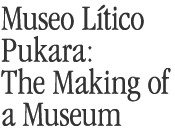

Left: The Pukara archaeological site with the Lagunita Mound in the background. Photo by Elizabeth Klarich, 2004. Right: Pukara style artifacts found on the modern ground surface of the Lagunita Mound during a site survey. Photo by Matt Wilhelm, 2006.
/ Published July 7, 2011
Why thousands of bureaucrats, priests, artisans and farmers settled some 2,000 years ago in the Lake Titicaca Basin of the Andes 13,000 feet above sea level and developed an important regional center there is a mystery. But Assistant Professor of Anthropology Elizabeth Klarich, who studies the origins of inequality and the development of early cities, has been trying to find out why, by conducting archaeological fieldwork in the southern Peruvian highlands for the past decade. In addition to her research, Klarich has been active in the development of the Museo Lítico Pukara, located in the adjacent town of Pucará (see sidebar).
Lily Samuels ’11, a student writer for Insight, sat down recently with professor Klarich to discuss her work as the director of the archeological excavation project at the ancient site of Pukara. They explored the interdisciplinary nature of ancient discovery, the politics of exploration and documentation, and the responsibility to work with — not against — local populations.
LS: As an anthropologist, what are your research interests?
EK: I’ve been most interested in the origins of urbanism. I ask: “Why do people shift from living in dispersed, semi-independent settlements and move into centers?” This is still a process we can see all over the world; we’re now more urban than rural as a planet and these processes have been going on for thousands of years.
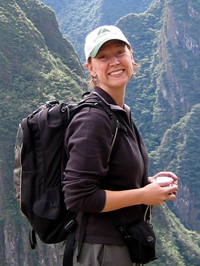
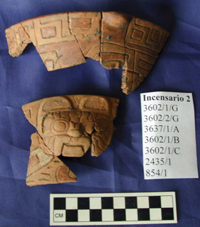
Top: Elizabeth Klarich at Machu Picchu. Photo by Shauna Mecartea. Above: Fragments of incense burners with feline imagery recovered during excavations at Pukara. Photo by Elizabeth Klarich, 2001. Click to enlarge.
LS: Where have you been primarily investigating these population movements?
EK: In the region where I work, at the site of Pukara in the Lake Titicaca Basin region of Peru, people moved from small centers into what we can call an early city about 2,000 years ago. In what remains of the site, we can see a downtown area with monumental structures, temple complexes and administrative buildings. It expands out close to a square mile with residential areas, production areas and other spaces that developed as people grew more interdependent.
LS: What role does archaeology play in your analysis of ancient history?
EK: Archaeology plays a large role in my analysis. I try to answer questions about early urbanism by analyzing ancient garbage. I have done settlement surveys — walked through Pukara, recording and reporting artifacts visible on the surface. Using ground-penetrating radar, we then decide where to excavate. After slowly unearthing the site, we move on to months of lab work. We have an interdisciplinary team: plant specialists, stone tool specialists, mapping specialists, architectural specialists — all of whom are needed to determine the different factors involved in reorganization.
LS: How did you get involved with Pukara and what has your relationship been to the site?
EK: The UNESCO research team that had been working at Pukara until the early 1980s was forced to leave the area because of the violence of the Shining Path insurrection throughout the highlands. When I was hunting around for a dissertation project in the late ’90s, everything I was encountering pointed to the unfinished business of Pukara. I launched into it for my Ph.D. in 2000. It was a long process of figuring out what I was looking to uncover, how I would dig and where. Ultimately, I was trying to discover what motivated people to move to this large site. With a team of Peruvians and Americans, I’ve continued to work at Pukara after my Ph.D. was finished in 2005. This summer, I’ll be staying in the U.S. and writing, trying to combine the results of a decade of excavation into a series of articles and a book.
LS: How do you, as a “foreigner,” gain access to the Pukara site?
EK: We work within the framework of Peruvian politics. I get permission to dig from the Ministry of Culture, a government office in Lima with branches in the different provinces. At the beginning of each calendar year, my Peruvian co-directors and I have to draft a detailed proposal. If we’re approved, we dig during the summer, write a report during the fall and start the process all over again. There’s plenty of bureaucracy, but it’s a collaborative effort with my team. Last year, we had three co-directors, two recent Ph.D.s and two Ph.D. candidates, a graduate student from Brazil, three Peruvian undergrads, a recent Smith graduate, and 11 undergrads from the U.S. as field school students, including one Smithie.
LS: When you’re on site, what are your roles? Are you able to “get dirty”?
EK: When I started in 2000, I was in an excavation unit all day long. But the last two years I’ve been doing mostly administration. We have tiers of supervision: people from the community and undergrads are supervised by grad students, who are supervised by a field director, and I am running around like a crazy person. I’ve watched my career evolve from being on the front of the discovery process to being the person who is facilitating the discovery for the supervisors and crew.
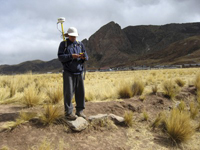
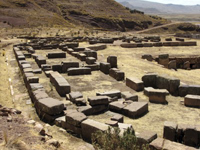
Top: Project co-director David Oshige documenting surface architecture at Pukara during site survey. Photo by Elizabeth Klarich, 2006. Above: View of central sunken enclosure on the main temple complex, the Qalasaya, at Pukara. Photo by Matt Wilhelm, 2006. Click to enlarge.
LS: What was this last summer like at Pukara?
EK: Busy. We spent a lot of time working on the local museum that we’re developing in the town and dealing with the community politics that have sprung up around that issue. We were also collaborating with local undergrads and their professors at the university in Puno. I was madly trying to keep up with the logistics of a large project like Pukara. I even had several students in and out of the hospital due health problems related to the elevation (13,000 feet above sea level).
LS: On an ethical level, are archaeological projects a sort of occupation?
EK: In a country where there is tension surrounding wealth and resource control, we have to be conscious of our place in the community and how we can either help or hurt. Our work is complicated. I come in as a foreigner with a pot of money, hiring local community members and working on (and reimbursing for) people’s lands. There’s an issue of employing some community members and not others and we have to consider how this impacts local power dynamics.
LS: Have there been any conflicts between your work with the community and any governmental agendas for development?
EK: Yes, there are constant negotiations between archaeologists and a number of different stakeholder groups, including government agencies, community members, development organizations, and tourist companies, just to name a few. For major archaeological sites like Pukara, a government agency typically relies on the research of national and international scholars to define site boundaries and demarcate areas as national patrimony. These site boundaries are then accompanied by use restrictions that affect the daily lives of local people who have traditionally relied on those lands for growing crops or grazing animals. Balancing these competing interests is, as one can imagine, highly political. Archaeologists often find themselves in the position of trying to simultaneously protect cultural resources while advocating for access by community members to traditional economic resources. To quote a colleague, “people can’t eat their history” and archaeologists often become involved in working with community members to transform cultural resources into innovative economic resources that are seen as worth preserving.













